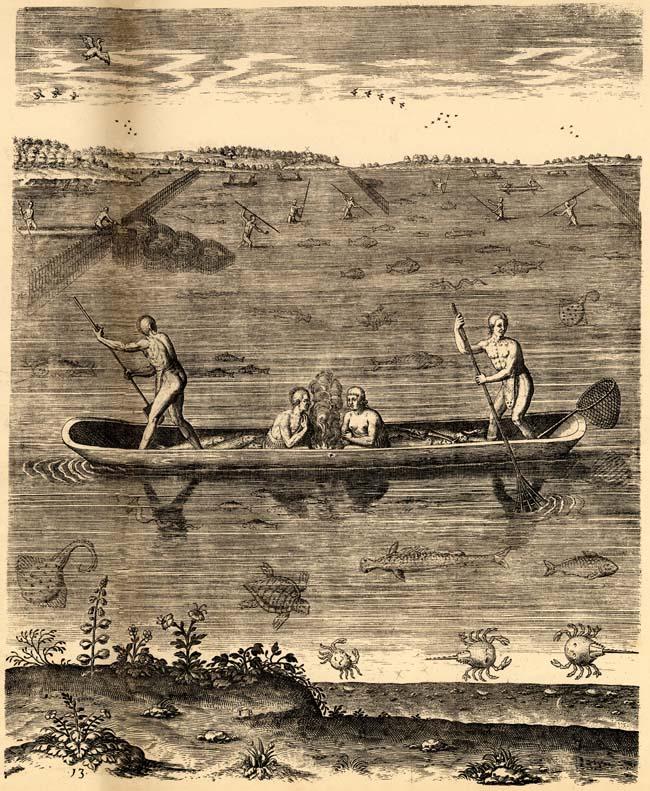Their Manner of Fishing in Virginia
Their Manner of Fishing in Virginia
"Their Manner of Fishynge in Virginia." Theodor de Bry's engraving of American Indians fishing, published in Thomas Hariot's 1588 book A Briefe and True Report of the New Found Land of Virginia. In the foreground, four Indians are in a canoe in the water: The two on the ends stand holding oars or nets in the water. The two in the middle are sitting. Various animals are visible in the water, including fish, crabs, and a turtle. In the background, numerous other Indians are fishing. Some stand in the water with harpoon-like tools, and others are in canoes. A few are fishing at weirs, traditional American Indian fishing devices consisting of a fence-like trap made of sticks or reeds.
The text accompanying the image reads:
They have likewise a notable way to catch fish in their Rivers, for whereas they lack both iron, and steel, they fasten unto their Reeds or long Rods, the hollow tail of a certain fish like to a sea crab instead of a point, where with by night or day they strike fish, and take them up into their boats. They also know how to use the prickles, and pricks of other fish. They also make wares, with setting up reeds or twigs in the water, which they so plant one within another, that they grow still narrower, and narrower, as appears by this figure. There was never seen among us so cunning a way to take fish withal, whereof sundry sorts as they found in their Rivers unlike unto ours, which are also of a very good taste. Doubtless it is a pleasant sight to see the people, sometimes wading, and going sometimes sailing in those Rivers, which are shallow and not deep, free from all care of heaping up Riches for their posterity, content with their state, and living friendly together of those things which god of his bounty has given unto them, yet without giving him any thanks according to his desert. So savage is this people, and deprived of the true knowledge of God. For they have none other than is mentioned before in this work .

Public Domain
Public Domain is a copyright term that is often used when talking about copyright for creative works. Under U.S. copyright law, individual items that are in the public domain are items that are no longer protected by copyright law. This means that you do not need to request permission to re-use, re-publish or even change a copy of the item. Items enter the public domain under U.S. copyright law for a number of reasons: the original copyright may have expired; the item was created by the U.S. Federal Government or other governmental entity that views the things it creates as in the public domain; the work was never protected by copyright for some other reason related to how it was produced (for example, it was a speech that wasn't written down or recorded); or the work doesn't have enough originality to make it eligible for copyright protection.
Add a comment
PLEASE NOTE: NCpedia provides the comments feature as a way for viewers to engage with the resources. Comments are not published until reviewed by NCpedia editors at the State Library of NC, and the editors reserve the right to not publish any comment submitted that is considered inappropriate for this resource. NCpedia will not publish personal contact information in comments, questions, or responses. If you would like a reply by email, note that some email servers, such as public school accounts, are blocked from accepting messages from outside email servers or domains. If you prefer not to leave an email address, check back at your NCpedia comment for a reply. Please allow one business day for replies from NCpedia. Complete guidelines are available at https://ncpedia.org/about.